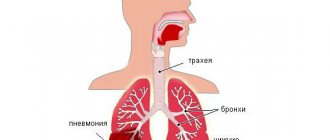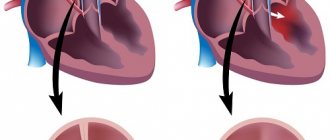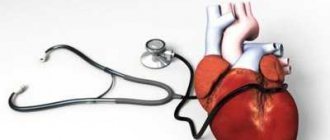Carditis is an inflammatory lesion of the heart of various etiologies that is not associated with rheumatism or other systemic diseases. In pediatrics, the expediency of using the term “carditis” is justified by the possibility of simultaneous damage to two or three membranes of the heart (endo-, myo- or pericardium).
Today, non-rheumatic carditis is diagnosed by specialists in all age groups, but mainly in children of the first years of life. According to autopsy data, this disease is found in 3-9% of children who died from various causes.
Carditis occurs as a result of the action of various factors, most often infectious, among which the main ones are the pathogens of scarlet fever, diphtheria and tonsillitis, as well as the Coxsackie, rubella and influenza viruses.
In addition, non-rheumatic carditis can be congenital (early and late). Early congenital carditis develops in those children whose mothers suffered from an acute viral or bacterial infection during 1-2 months of pregnancy. In turn, late congenital carditis in children occurs as a result of infectious diseases that a woman developed in the last weeks of pregnancy.
Congenital carditis is observed relatively rarely. This pathology can be suspected if the condition of the newborn is characterized by pronounced symptoms of an intrauterine infection, which is accompanied by damage to many systems and organs.
Bacterial flora, protozoal invasions and fungi play a certain role in the development of non-rheumatic carditis. In addition, the disease can be the result of an allergic reaction to the administration of drugs, serums, vaccines, and also occur under the influence of various toxic factors, radiation, and physical agents.
Modern pediatric practice identifies the following types of carditis in children:
- congenital and acquired (depending on the period of occurrence);
- acute, subacute and chronic (based on their etiology and nature of the course).
In addition, the severity of heart failure, the severity of the pathology, as well as possible complications and outcomes are taken into account.
Which membranes of the heart are affected in carditis?
Inflammation of the heart, accompanied by damage to its inner lining, the endocardium, is called endocarditis .
Inflammation during endocarditis can affect the valvular apparatus of the heart and the aortic opening, leading to the formation of acquired valvular defects of varying severity. Carditis that affects the middle (muscular) layer is called myocarditis. Myocardial inflammation can be complicated by the development of heart failure, life-threatening arrhythmias and the formation of dilated cardiomyopathy.
Inflammation of the outer layer of the heart (epicade), which is the inner layer of the pericardium (pericardial sac) and the pericardium itself, is called pericarditis. Pericarditis can lead to the development of cardiac tamponade, heart failure (HF), etc.
In cases where carditis affects all layers of the heart, the disease is called pancarditis.
For reference. Due to the many reasons for the development of carditis, they are divided into rheumatic and non-rheumatic inflammation.
Symptoms
The first symptoms are difficulty breathing, shortness of breath, pallor or cyanosis (blue color) of the visible mucous membranes. The general symptoms are supplemented by cough, stomach problems, and nervous system disorders. On the electrocardiogram you can see disruptions in the rhythm of varying degrees of severity. The first manifestations of signs of inflammation of the membranes of the heart are not simple, and therefore they require special monitoring by a cardiologist.
The type of progression of the disease rarely makes it possible to directly identify cardiac diseases. Especially in situations where carditis is acquired after an infectious disease. The patient feels weak, gets tired quickly, eats poorly, feels nauseated, and has decreased attention. Similar general symptoms are characteristic of many diseases. In young children, carditis is accompanied by cough and heart pain. The baby is not able to report painful sensations; he tries not to move abruptly and breathe shallowly.
As the disease develops, the symptoms become even more pronounced and clear. Then rapid heartbeat, tachycardia, dull heart sounds begin to occur, difficulty breathing, swelling, cyanosis, pain in the cardiac region, and cough often appear. However, this does not indicate the appearance of carditis, since the symptoms are similar to such manifestations of heart diseases as arrhythmia, tumor formations that affect the myocardium, mitral stenosis, and heart disease.
Non-rheumatic carditis - what is it?
Non-rheumatic carditis is an inflammation of the heart that is not associated with infection with group A beta-hemolytic streptococci or the presence of systemic diseases affecting the connective tissue.
In this formulation, the concept of carditis is a general term, implying that inflammation can involve either one or several linings of the heart.
Attention. In non-rheumatic carditis in children and adults, isolated damage rarely occurs. As a rule, inflammation affects all cardiac membranes with a predominant lesion of one of them ( myocarditis , accompanied by signs of endocarditis, pericarditis, accompanied by inflammation of the myocardium, etc.).
The main clinical picture of the disease depends on which cardiac membrane is most severely damaged. Therefore, when making a diagnosis of carditis, clarification of the location of the lesion (myocarditis, endocarditis, pericarditis, pancarditis) is mandatory.
Treatment
Complex heart disease such as rheumatic carditis is treated in children over a long period of time, in stages. The method of complex treatment is determined primarily by how timely the pathology was identified and how advanced it is. The causes and forms of manifestation of the disease, concomitant chronic diseases, and the general condition of the child (psychological, physical) are taken into account.
Acute forms of the pathology require immediate hospitalization. The child can stay in the hospital from 10 days to a month. A strict pastel regime is prescribed, the course of treatment begins with etiotropic antibacterial drugs. Additionally, oxygen therapy may be prescribed when the disease has become advanced and the child is very difficult to tolerate treatment.
The attending physician for rheumatic carditis develops the correct diet specifically for each child. Preference is given to foods enriched with vitamins, potassium salts, dried apricots, raisins, and baked potatoes. Remove salt from the diet, foods that contribute to the formation of edema, and those that retain fluid in the body (smoked, salted). Everything harmful that is currently contraindicated for the child is removed from the diet.
To relieve acute inflammation of the membranes of the heart, in some cases, doctors allow outpatient treatment. For about 2 months, anti-inflammatory non-steroidal drugs such as Voltaren, Indomethacin, Prednisolone are prescribed. Additionally, vitamin complexes, antihistamines, and potassium are prescribed. Diuretics and cardiac glycosides may be prescribed. When intravascular blood coagulation is observed, something is prescribed to improve microcirculation, normalizing metabolic processes in the myocardium.
Depending on the course of the disease, antiarrhythmic therapy and physical therapy are prescribed, excluding heavy physical activity. Then the child is sent to recover in health centers, sanatoriums, cardiology institutions. In addition, the treating specialist constantly monitors the child over the next 12 months after treatment; to confirm complete cure, the child undergoes an ECG every three months. For five years after treatment, any preventive vaccinations are prohibited.
Non-rheumatic carditis - causes
Carditis belongs to polyetiological diseases, that is, they can develop under the influence of infections, toxins, various medications, allergens, etc.
Important. One of the leading causes of the development of non-rheumatic carditis are viral agents that have a high affinity for myocardial cells.
The viral theory is supported by the fact that the incidence of carditis increases during the season of viral infections.
Pathogenesis of carditis development (diagram):
Most often, heart inflammation develops when patients are infected with viruses:
- flu,
- rubella,
- chicken pox,
- herpes simplex,
- parvovirus B19,
- ECHO,
- Coxsackie A and V.
Important. In the occurrence of congenital non-rheumatic carditis in children, the leading role is played by viral diseases suffered by the mother during pregnancy.
Bacterial non-rheumatic carditis in children and adults occurs against the background of:
- diphtheria,
- typhoid fever,
- chlamydia,
- mycoplasmosis,
- meningococcal infection,
- staphylococcal infections.
Parasitic inflammation of the heart most often develops against the background of toxoplasmosis and schistosomiasis.
In the etiology of fungal carditis, the most important role is played by coccidioides (the causative agent of coccidioidomycosis), aspegillus, fungi of the genus Candida, and histioplasma.
Allergic and autoimmune carditis can develop after contact with various allergens, administration of vaccines or serums. Also, the development of carditis can be caused by taking certain drugs (methyldopa, sulfonamides, cytostatics), exposure to toxins, ionizing radiation, etc.
Attention. In approximately ten percent of patients, the true cause of inflammation of the heart membranes cannot be determined.
Predisposing factors that create favorable conditions for the development of carditis are various vasculitis, genetic diseases accompanied by immune disorders, primary and secondary immunodeficiency conditions, hereditary diseases with myocardial hypersensitivity.
Pathogenesis of the disease
Non-rheumatic carditis develops as a result of the direct cardiotoxic effect of the pathogen with the formation of destructive and inflammatory changes in the membranes of the heart muscle. As a result of the introduction of an infectious agent, the formation of cytotoxic T-lymphocytes, antibodies to cardiomyocytes, and CECs occurs, which cause allergic reactions. As a result, different structures of the heart undergo destructive changes, which causes:
- disruption of its microcirculation and vascular permeability;
- destruction of myofibrils;
- the occurrence of thromboembolism and tissue hypoxia.
The combined influence of immunopathological processes and an infectious agent mainly causes the development of acute carditis. As for the chronic process, autoimmune reactions play a key role in it.
Outcomes and complications of carditis
With timely diagnosis and adequate treatment, heart inflammation can proceed safely. However, carditis can also lead to the development of:
- cardiosclerosis;
- heart failure;
- myocardial hypertrophy or the formation of dilated cardiomyopathy;
- various rhythm and cardiac conduction disorders;
- pulmonary hypertension;
- lesions of the valvular apparatus of the heart with the formation of acquired heart defects;
- constrictive myopericarditis;
- cardiac tamponade;
- thromboembolic complications.
Diet
Non-pharmacological treatment includes a specific diet:
- For an infant who is fed only breast milk, other foods are contraindicated; only additional vitamins and minerals are prescribed.
- A child who is usually allowed any food is prescribed a low-salt diet,
- Liquids per day should be consumed no more than one liter, especially in the presence of peripheral edema,
- Limit your intake of fats and carbohydrates,
- Add a large amount of vitamins, fatty acids, and essential amino acids to your diet.
Congenital non-rheumatic carditis in children
Congenital non-rheumatic carditis in children is characterized by an extremely variable clinical picture, depending on the time of occurrence of inflammation of the heart and the severity of damage to the membranes of the heart by the inflammatory process.
Carditis in children (development diagram):
The development of early congenital carditis in children, as a rule, occurs at 4-7 months of pregnancy.
For reference. Children with early carditis have no signs of inflammation, but the presence of proliferation of cardiac tissue, fibroelastosis and elastofibrosis is characteristic. That is, a child is born not with the clinical picture of carditis itself, but with its outcome: impaired ability of the heart to contract, fibrous tissue degeneration, etc.
Such changes are due to the fact that fetal tissues are not yet able to respond to the action of damaging agents with a full-fledged inflammatory reaction, and trigger the processes of proliferation of connective tissues. This leads to the formation of areas of fibrosis and fibroelastosis, in which normal cardiac tissue is replaced by fibrous and elastic tissue that is not capable of performing the functions of cardiac tissue.
The development of late carditis in children occurs in the third trimester of pregnancy. The later the exposure to a damaging agent occurs (most often it is a viral infection), the more pronounced the usual inflammatory reaction without signs of fibrotic degeneration of heart tissue.
For reference. In late carditis, fetal tissues respond to the action of the damaging agent with a full-fledged inflammatory reaction. Therefore, late congenital non-rheumatic carditis occurs in the same way as acquired inflammation of the heart.
The outcome of late congenital carditis in children can be a persistent disturbance of heart rhythm and conduction.
In such children, already in the neonatal period, extrasystoles, atrial flutters, paroxysmal and non-paroxysmal tachycardias, atrioventricular blocks, etc. can be detected.
It should be noted that in both early and late carditis in children, the main symptoms of heart inflammation appear immediately after the birth of the baby, or during the first two to three months of life. In this case, there is no contact of the child with a viral, bacterial or any other infection.
Early carditis in newborns - symptoms
Early congenital carditis in children is characterized by signs of dilatation of the heart chambers and impaired ability of the heart to contract from birth.
The main clinical manifestations of early congenital carditis will be the occurrence of:
- cardiomegaly and heart failure (initially, as a rule, left ventricular failure develops, and then total failure occurs), - increased heart rate,
- pronounced pallor of the skin,
- shortness of breath,
- increased breathing rate,
- constant snoring and coughing (in the absence of signs of damage to the respiratory system).
Cyanosis of the nasolabial triangle.
From the first days of a baby's life, attention is drawn to his pallor, lethargy, and the appearance of cyanosis of the nasolabial triangle (may appear or intensify with coughing, feeding, crying, screaming, etc.).
Poor appetite and low weight gain are also noted.
In the presence of HF associated with fibroelastosis, the patient typically does not respond to the therapy.
In rare cases, the first symptoms can be smoothed out and intensified only with the addition of a concomitant infectious disease.
Late carditis in a child - symptoms
In babies with late carditis, the first symptoms most often appear from the first to the sixth month of life. Earlier or later manifestations of carditis are quite rare.
Signs of the subacute form
A distinctive feature is conduction disturbances, which most often characterize the disease:
- Blockades
- Extrasystoles,
- Atrial fibrillation,
- Change in heart rate.
The disease usually begins slowly. The child may complain of fatigue and loss of appetite, and will seem lethargic and lacking initiative. Afterwards shortness of breath and signs of heart damage appear.
In the case of streptococcal etiology, inflammation of the joints, impaired renal function, possibly chorea or subcutaneous nodes appear.
Diagnostics
To diagnose heart inflammation, the following is carried out:
- examination, palpation, auscultation and collection of anamnestic data;
- general blood and urine tests, biochemistry with determination of markers of myocardial damage, and a coagulogram. Kidney and liver functions are also assessed;
- ECG and ECHO-CG;
- radiography of the chest organs (chest organs) to detect cardiomegaly and congestion in the lungs;
- assessment of the severity of HF, the risk of thromboembolic complications, the development of chronic carditis, etc.
Classification
This pathology can be acquired or congenital. In addition, according to ICD 10, the disease is classified according to the characteristics of its course, according to which carditis can be:
The acute course is spoken of when the disease lasts less than three months, the subacute form progresses over about a year and a half, and the chronic form is spoken of when the disease progresses over several years. At the same time, the chronic course of this pathology can be recurrent and primary chronic.
Recurrent chronic carditis is characterized by the fact that the disease constantly retreats and then reactivates. Carditis with a primary chronic course can be congestive, hypertrophic and restrictive.
According to its forms, the disease is divided into mild, moderate and severe. According to the degree of heart failure, there are carditis with left ventricular failure and with right ventricular failure. A total type of pathology, when general heart failure develops, is not excluded.
This disease is fraught with serious complications, including:









